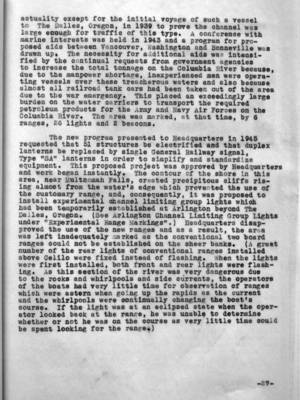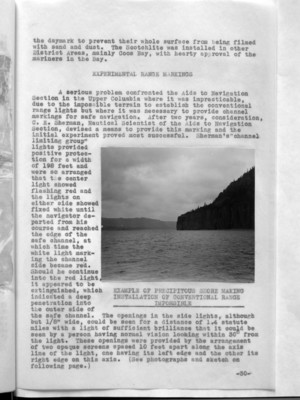Pages That Mention Experimental Range Markings
Coast Guard District narrative histories 1945
46
actuality except for the initial voyage of such a vessel to The Dalles, Oregon, in 1939 to prove the channel was large enough for traffic of this type. A conference with marine interests was held in 1943 and a program for proposed aids between Vancouver, Washington and Bonneville was drawn up. The necessity for additional aids was intensified by the continual requests from government agencies to increase the total tonnage on the Columbia River because, due to the manpower shortage, inexperienced men were operating vessels over these treacherous waters and also because almost all railroad tank cars had been taken out of the area due to the war emergency. This placed an exceedingly large burden on the water carriers to transport the required petroleum products for the Army and Navy Air Forces on the Columbia River. The area was marked, at that time, by 6 ranges, 26 lights and 2 beacons.
The new program presented to Headquarters in 1945 requested that 51 structures be electrified and that duplex lanterns be replaced by single General Railway signal, Type "SA" lanterns in order to simplify and standardize equipment. This proposed project was approved by Headquarters and work began instantly. The contour of the shore in this area, near Multnomah Falls, created precipitous cliffs rising almost from the water's edge which prevented the use of the customary range, and, consequently, it was proposed to install experimental channel limiting group lights which had been temporarily established at Arlington beyond The Dalles, Oregon. (See Arlington Channel Limiting Group Lights under "Experimental Range Markings".) Headquarters disapproved the use of the new ranges and as a result, the area was left inadequately marked as the conventional two board ranges could not be established on the sheer banks. (A great number of the rear lights of conventional ranges installed above Celilo were fixed instead of flashing. When the lights were first installed, both front and rear lights were flashing. As this section of the river was very dangerous due to the rocks and whirlpools and side currents, the operators of the boats had very little time for observation of ranges which were astern when going up the rapids as the current and the whirlpools were continually changing the boat's course. If the light was at an eclipsed state when the operator looked back at the range, he was unable to determine whether or not he was on the course as very little time could be spent looking for the range.)
-27-
50
the daymark to prevent their whole surface from being filmed with sand and dust. The Scotchlite was installed in other District Areas, mainly Coos Bay, with hearty approval of the mariners in the Bay.
A serious problem confronted the Aids to Navigation Section in the Upper Columbia where it was impracticable, due to the impossible terrain to establish the conventional range lights but where it was necessary to provide channel markings for safe navigation. After two years, consideration, C. E. Sherman, Nautical Scientist of the Aids to Navigation Section, devised a means to provide this marking and the initial experiment proved most successful. Sherman's "channel limiting group" lights provided positive protection for a width of 198 feet and were so arranged that the center light showed flashing red and the lights on either side showed fixed white until the navigator departed from his course and reached the edge of the safe channel, at which time the white light marking the channel side became red. Should he continue into the red light, it appeared to be extinguished, which indicated a deep penetration into the outer side of the safe channel. The openings in the side lights, although but 1/8" wide, could be seen for a distance of 1.4 statute miles with a light of sufficient brilliance that it could be seen by a person having normal vision looking within 30° from the light. These openings were provided by the arrangement of two opaque screens spaced 10 feet apart along the axis line of the light, one having its left edge and the other its right edge on this axis. (See photographs and sketch on following page.)
(image) EXAMPLE OF PRECIPITOUS SHORE MAKING INSTALLATION OF CONVENTIONAL RANGE IMPOSSIBLE
-30-

